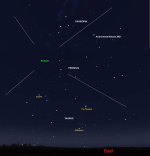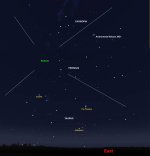You are using an out of date browser. It may not display this or other websites correctly.
You should upgrade or use an alternative browser.
You should upgrade or use an alternative browser.
*** The Official Astronomy & Universe Thread ***
- Thread starter PermaBanned
- Start date
More options
Thread starter's postsA look at GJ 3253 and how it has helped understanding how the magnetic field in the Sun and stars like it are generated:
More:
https://www.cfa.harvard.edu/news/2016-16
More:
https://www.cfa.harvard.edu/news/2016-16
Was going to get up tomorrow night at silly o'clock to look at the Perseids... But the forecast all this week is clouds
Best mornings are on the 12th and 13th:
If clear, these mornings should give us a chance of observing the Perseid meteor shower - produced by debris from the comet Swift-Tuttle. The early morning of the 12th August will give us the best chance, if clear, of viewing the shower, but the peak is quite broad and so its well worth observing on the nights before and after. Most meteors are seen looking about 50 degrees from the "radiant" which lies between Perseus and Cassiopeia. This year is the Moon is quite low in the sky and sets soon after midnight so the best time to observe is in the early hours of the 12th. Under cloudless skies and from a dark location observers might expect to see 50 to 70 meteors an hour near the peak, but it is possible that this year's display will be considerably better.

...and the forecast all week is clouds! Just got to hope the weekends clear skies arrives early for the night of Thu/Fri!? - http://earthsky.org/?p=74160
Last edited:
Soldato
- Joined
- 3 Oct 2009
- Posts
- 19,893
- Location
- Wales
Clouds are rapidly clearing as the evening goes by after torrential rain all day. Will be getting out on the balcony in the early hours for a look 

The discovery of "Hanny's Voorwerp" in 2007:
This unusually-shaped cloud of gas, which also has another nickname of the "green blob," is located only about 200,000 light years from the galaxy IC 2497. While this sounds like a huge distance, it is actually very close in cosmic terms. Because of that, Hanny's Voorwerp is affected by what goes on in IC 2497, in particular by the behavior of the giant black hole at its center. In fact, the green blob gets its color because oxygen atoms in the gas cloud have been excited by the incoming ultraviolet and X-ray radiation from regions close to the black hole.
Even though astronomers suspect this black hole was a so-called quasar in the past, recent Chandra observations indicate that it has since faded. So far, Hanny's Voorwerp shows no sign of dimming, but with the 200,000 light year separation, astronomers in the upcoming millennia might just see the lights in the green blob start to flicker off.
New observations with Chandra suggest that the black hole is still producing large amounts of energy even though it is no longer generating intense radiation as a quasar. The X-ray data suggest that jets powered by the black hole have blown a large bubble in surrounding gas. This shows that giant black holes can have a big effect on their environments.
Clouds are rapidly clearing as the evening goes by after torrential rain all day. Will be getting out on the balcony in the early hours for a look
Did you see them?
Soldato
- Joined
- 3 Oct 2009
- Posts
- 19,893
- Location
- Wales
Did you see them?
Nope, by 10pm it was total cloud cover again. So much so I couldn't even see the moon
 Got up in the early hours just in case and it was the same. Blue skies by 7am though
Got up in the early hours just in case and it was the same. Blue skies by 7am though 

Soldato
- Joined
- 9 Jan 2008
- Posts
- 6,491
- Location
- London/Camberley
Saw a couple here. Will try again tonight if it's clear.
Nope, by 10pm it was total cloud cover again. So much so I couldn't even see the moonGot up in the early hours just in case and it was the same. Blue skies by 7am though

Was hoping for tonight as we're having a clear evening but it's going to cloud over after midnight.

The Perseid meteor shower from the ISS as two meteors streak across the sky above Pakistan within the span of about 10 seconds:
The video was taken August 10 with a high resolution video camera and was provided by Tomoko Arai/Japan’s Planetary Exploration Research Center/Meteor Composition Determination (Meteor) investigation.
The video was taken August 10 with a high resolution video camera and was provided by Tomoko Arai/Japan’s Planetary Exploration Research Center/Meteor Composition Determination (Meteor) investigation.
Venus and Jupiter are converging for a spectacular conjunction in the sunset sky on August 27th:
For UK:
For UK:
Looking west after sunset and given a very low horizon in this direction, binoculars may help you spot Jupiter and Venus less than half a degree apart. But please do not use binoculars until after the Sun has set.


